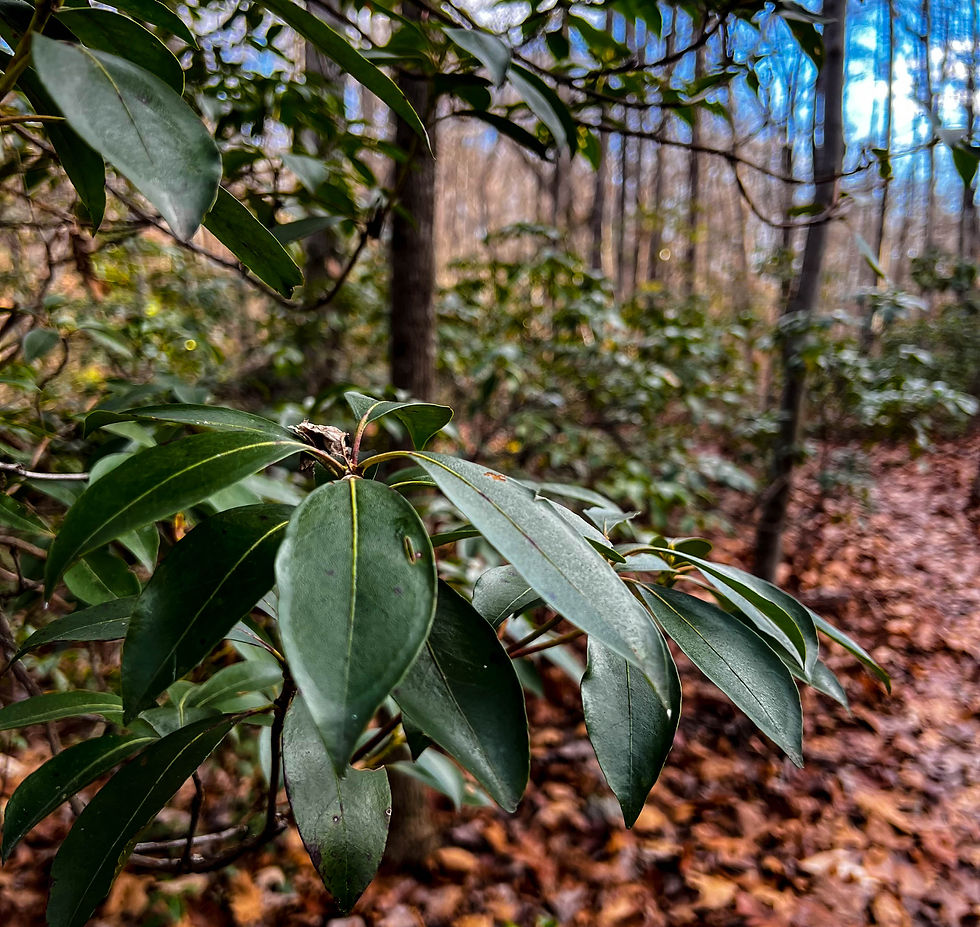A Year in the Life of Pimmit Run: Winter Solstice 2022
- barbararyan9
- Dec 21, 2022
- 3 min read
Today is winter solstice, the shortest day and longest night of the year, and the time when the sun is at its lowest elevation in the sky. At this time of the year, when the sun does shine, it does so intensely. The result is a remarkable contrast of lightness and darkness that starkly highlights nature's beauty in the Pimmit Run Stream Valley.

Stream Illumination
The stream valley is especially quiet this time of year. The water meanders quietly (unless it's just after a storm when it gushes furiously!). Pockets of still water appear here and there, mirroring the bare trees and blue sky. The colors are almost blindingly bright for the brief period of time the sun does shine.

Evergreens Take Center Stage
Evergreens, sparse in this ecosystem, play an essential role in the winter stream valley landscape. They create welcome spots of green and shelter for wildlife. The native Mountain Laurel (Kalmia latifolia) is a signature native evergreen shrub in the Oak-Beech/Heath Forest natural plant community where it grows in large, spreading groves, preferring acidic soil and north-facing slopes. Mountain Laurel thrives in this natural environment in a way that is exceptionally difficult to mimic in cultivated landscapes.

Evergreen trees in the natural plant communities of this stream valley are largely limited to our native American Holly (Ilex opaca). It flourishes in the streamside floodplain valley floor, often growing close to the water and spreading seedlings abundantly.

Everdeciduous Trees
And then there is a phenomenon called marcescence, in which certain native deciduous trees, known as everdeciduous trees, retain their leaves through winter. Everdeciduous trees that are common in the natural plant communities of this stream valley include Oak (Quercus spp.), American Beech (Fagus grandifolia), American Hornbeam (Carpinus caroliniana), and Witch Hazel (Hamamelis virginiana). Everdeciduous trees have a number of advantages -- they are said to deter deer browsing, they provide shelter for wildlife, and they provide interest in the barren winter landscape! The American Beech, with its telltale smooth gray bark, is perhaps most persistent in displaying this trait, at times holding onto its leaves almost until spring.

Birds at Play
Its easier to see birds this time of year, offering great opportunities for bird-watchers! Evergreen and everdeciduous tree leaves provide excellent cover for overwintering birds and can be a bird photographer’s dream. Hang out near them, and enjoy the show.

Forest Floor
The forest floor puts on its own unique wintery show. Goldenrod (Solidago spp.), White Wood Aster (Eurybia divaricatus), and Deertongue (Dichanthelium clandestinum) faded brush and seedheads (left to right below) can be spotted here and there, adding variety to the landscape floor and sowing seeds for the future. A more muted look than when they are in their greener/blooming prime, but spectacular nonetheless.
Native orchids are another unusual horticultural delight that can be seen in winter. Crane-fly Orchid (Tipularia discolor) is now making a fresh appearance on the floodplain floor, viewable by those who know where to look. This native orchid appears regularly in the same spots annually, and sends up its distinct fresh leaves at this time of year, which hug the ground and peek out from beneath the fallen leaves.

Partridgeberry (Mitchella repens) is another native wonder that can be found growing densely in areas along the stream valley floor. This diminutive native groundcover can be found nestled in the dense leaf litter while sporting vibrant edible red berries.

And the Christmas Fern (Polystichum acrostichoides) is looking particularly vibrant, since, of course, it's that time of year.

Mosses, usually overlooked in the dense greenery through the year, visually pop now along streambank spots and on tree trunks. Mosses like damp spots, and growing up the north side of tree trunks, which provide a good vertical growing surface with grooves and crevices to hang onto.


Looking Forward
Now we officially enter the season of winter and from this point forward, the days get longer. The stream valley offers a special ability to connect with nature during these cold months, as the earth gradually awakens for another spring.
Note: all photos taken by the author.










Thank you for this post. I will have fun looking for the orchid you spoke of. I have also enjoyed looking closely at the many varieties of fungi spotted on dead tree trunks. Love to share my pics with you for another future post. Winter is a wonderful time for peering into the forest to discover finds we cannot see in the flush of summer’s dense foliage.